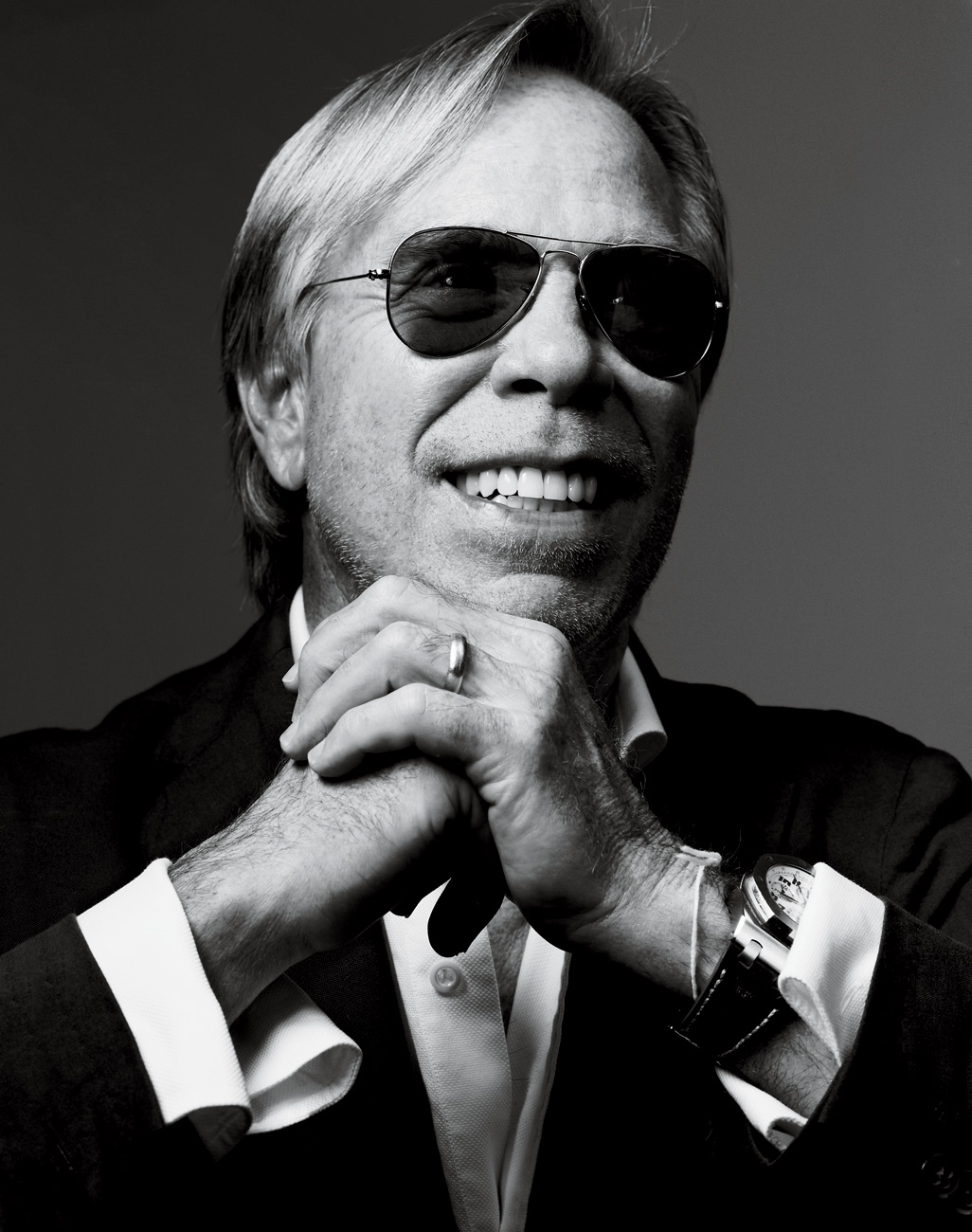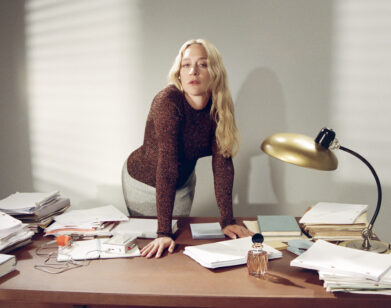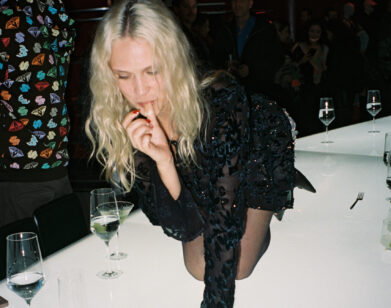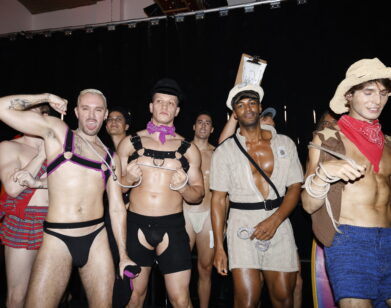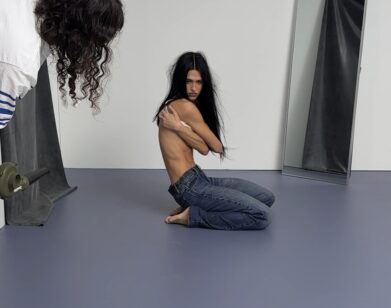Tommy Hilfiger
As the folklore has it, Tommy Hilfiger got his start in fashion at the height of the rock ‘n’ roll revolution of the late 1960s, running bell-bottoms from Manhattan up to his style-starved hometown of Elmira, New York. But whether trafficking in flared jeans or designing country-club sportswear, Hilfiger has always had a knack for tapping into unexpected quarters of youth culture at just the right moment. When Hilfiger launched the Tommy Hilfiger brand in 1985 with his now-famous neoplasticist logo and a Tommy-centric ad campaign created by the legendary ad man and art director George Lois, he helped fuel the preppy explosion of the decade by designing clothes that were, in his formulation, classic, but with a twist, and appealed to a kind of newfound Reagan-era American Dreaming that Hilfiger himself came to, in part, represent. His stark reimagination of the brand in the 1990s once again played off that idea, albeit in a drastically different way, as Tommy Hilfiger captured the urban market by becoming the de facto status label of the hip-hop nation. This decade, Tommy Hilfiger has once again been reinvented as the embodiment of a new kind of sporty American luxury.
This year marks the 25th anniversary of Tommy Hilfiger, and to celebrate, the brand has produced a history-spanning volume, Tommy Hilfiger (Assouline), which was released in September. Business is also robust: In March, Phillips-Van Heusen, owners of Calvin Klein, purchased the Tommy Hilfiger Corporation for a reported $3 billion. But the 59-year-old Hilfiger isn’t about to pack it in, overseeing a planned foray into the home furnishings arena and a series of other initiatives aimed at growing Tommy Hilfiger into a global lifestyle proposition. Jimmy Fallon recently caught up with Hilfiger, who spent the summer a long way from Elmira, having just returned from a stay at his house on the island of Mustique.
JIMMY FALLON: When did you get the bug and go, “I’m going to be in fashion”?
HILFIGER: In the late ’60s, when the hippie revolution was taking place, all of my friends and I wanted to look like rock stars. The Beatles, the Stones, the Who, Jimi Hendrix-these are the people we wanted to look like, and they were all wearing long hair and bell-bottoms. We wore long hair and bell-bottoms to school, and the other kids wanted to look like us. So a couple of friends and I decided to open a shop while we were still in high school. We pooled together $150 each and called it People’s Place. We opened with an inventory of 20 pairs of bell-bottoms. But then I went bankrupt when I was 23 years old, and it was like cold water in the face. It was a wake-up call because we had this business, and we had opened about 10 stores and it was going really strong. Then all of the sudden one day we found out we were out of money and bankrupt.
FALLON: Where were you at the time?
HILFIGER: I was in upstate New York. We were opening stores on college campuses. My partners and I were also partying it up at Studio 54 and Max’s Kansas City and hanging out in the city and not really paying attention to the business. So that was a lesson learned.
FALLON: So then you decided to go out on your own?
HILFIGER: Yeah. I decided to move to the city and really go into design full time. In the beginning, I really struggled, because I was designing for this company and ultimately wanted my own, but that takes a lot of money. So I found a backer and was lucky enough to have success.
FALLON: Did you find it easier to work when you were first starting out, because the whole operation was smaller?
HILFIGER: No, because I really had no money then. It was like hand-to-mouth for many years. But then I met this Indian man by the name of Mohan Murjani who backed me, and we were partners for a number of years before I bought him out with a group of new partners. It was once I had financing that I could really grow the business.
FALLON: At what point were you like, “Man, I’m successful. This is working.”
HILFIGER: I think it’s dangerous to think that you’re successful, because then you become complacent. I think you’ve got to stay humble. In this business, you have to look over your shoulder at all times because you can lose it all with the snap of a finger.
FALLON: When I think of you, I see red, white, and blue. Is that weird to say?
HILFIGER: No, because every designer has their own signature or their own attitude or look, and red, white, and blue has been a big part of mine forever.
FALLON: Why? Because of America?
HILFIGER: Well, because it’s an American brand. But I also love everything nautical and seafaring and sportier looks. I really like clean looks, like something from a country club or from tennis or rugby. I think they’re wearable. It’s something I put into my collection early on and it caught on.
FALLON: And then there was a time when you really became the face of urban fashion.
HILFIGER: I was the designer of choice in the urban market in the early ’90s.
FALLON: How did that change your business?
HILFIGER: Well, you know, in the fashion business, you go through cycles of trends, and that was a trend at the time, and I was the leader of it. But I never really abandoned my roots of being sort of preppy, all-American classic, which has carried us worldwide because it travels well.
FALLON: It was definitely a cool thing. As a fan of yours, it has been fun to watch how the reinvention happens. Sometimes you reinvent yourself, and then sometimes people find you and reinvent you.
HILFIGER: It’s best when they find you.
FALLON: Is there anything fashion-wise that you’ve never tried and would never do?
HILFIGER: I’ve never tried to do couture, because it’s a whole different beast. You know, Dior, Saint Laurent, all of the haute couture French designers have these amazing, one-of-a-kind lines. It’s really an art unto itself.
FALLON: In your secret diary that no one reads, who do you say that you’re jealous of?
HILFIGER: Who am I jealous of? Every time I pass a Ralph Lauren store, I think, I know he’s been in business for more than 40 years and I’ve only been in business for 25, but, boy, do I ever want what he’s got.
FALLON: That’s the one, huh?
HILFIGER: I look up to Ralph and have tremendous respect for him. But I have to say, I do get a little jealous.
FALLON: For me, I’d say it’s Tina Fey. I’m jealous of her because I see her work and I go, “Man, I wish I could do what she can.”
HILFIGER: I’ll bet she wishes she had your show.
FALLON: [laughs] Right. She should. Everyone should. So now that Tommy Hilfiger has gone global, what is there left to do?
HILFIGER: Well, you know, we’re a lifestyle brand, but we need to add the furniture and home furnishings, so we’ll be trying that now. But ultimately I’d like to open a hotel.
FALLON: Really? Like a nautical-type thing?
HILFIGER: Yeah, like sort of pop culture, where we could have live bands and a really cool spa. Somewhere you’d want to go hang out.
FALLON: That should definitely be the next move: The Hilfiger Hotel.
HILFIGER: And if we had Jimmy Fallon hanging out at the bar, everyone would want to come hang out.
FALLON: That’s not too hard. Jimmy Fallon hangs out at a lot of bars-sadly.
HILFIGER: We’ll have to build the Fallon Club.
FALLON: Yeah. A room with just a single glass set up-and it’s a bottomless glass. Did you always have Hilfiger in mind as the name of your company? Or was there a second name that you were close to considering?
HILFIGER: I shortened the name once to Tommy Hill. I thought it would be much easier to pronounce, but my partner at the time, Murjani, said, “No. Just use your real name. Nobody has the name Hilfiger, so nobody will confuse it with another name.” So I just stuck with it. Even though most people still come up to me and say, “Are you Tommy Hilfinger?”
Jimmy Fallon is the host of NBC’s Late Night with Jimmy Fallon.

